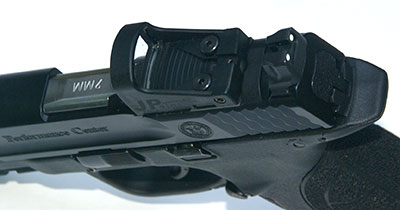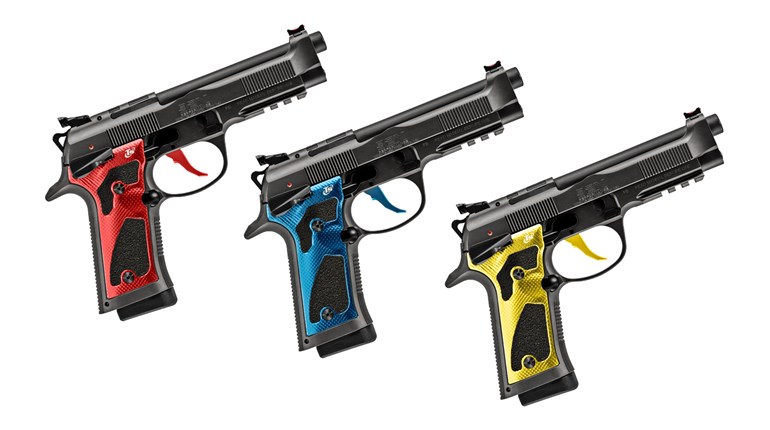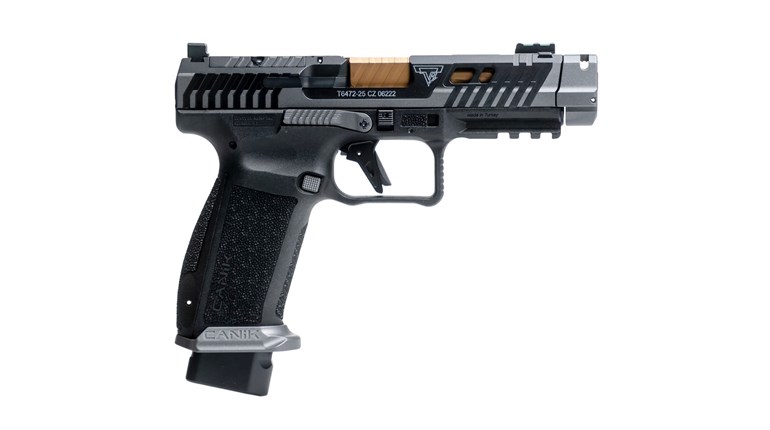
Their lightweight, ergonomics, and quick handling have also made them a favorite among competitive action pistol shooters. Popular enough that many have sought to modify them to allow for the installation of optical sights. Given the polymer frame that can be an expensive custom gunsmithing proposition, but S&W just made that a lot easier with the introduction of the C.O.R.E. series.
The Guns
C.O.R.E. stands for “Competition Optics Ready Equipment”. The models feature a precision cut-out on the top of the slide just forward of the rear sight. Five supplied mounting plates fit the cut-out and the mounting hole pattern of the popular red dot reflex sights. This allows any to be quickly installed or removed. Shooters now have the option running a red dot sight, or the iron sights, with minimal effort on their part.

This five-inch gun weighs in at 24.1 ounces. Despite the extra three-quarter-inch of barrel and slide it's virtually identical in weight to my 24-ounce standard 4.25-inch M&P 9mm. That makes it a quick-handling gun. The weight reduction was achieved via two trapezoidal ports on the barrel and eight round cut outs on the upper front of the slide.

In addition to the ported barrel the Performance Center model features an adjustable trigger overtravel stop. The trigger on my gun was crisp with no creep and a minimal amount of take up. Unfortunately, the pull weight was about six-pounds. That's heavier than I prefer on a gun of this type, but common on factory guns. There are a number of gunsmiths that can “refine” it down to the 2.5-3.5 pound range.
On The Range
Although I intended to use the gun with a reflex optical sight my first step was to zero the iron sights in case they were ever needed. At 25-yards the elevation was perfect with my preferred 147-grain loads, although it was grouping about five-inches left. That was easily corrected with the drift adjustable rear sight.

The JPoint is adjustable for windage and elevation, but zeroing is done differently than with conventional sights. You don't adjust the sight to move the point of impact to where you want it. Instead you move the dot to where the group is impacting—which then brings dot and group together. It's the reverse of standard sight-in procedures but I found it very easy. The iron sights are visible through the JPoint window. Since they were already zeroed I just braced the gun on my kitchen table, aligned the sights on a small spot on a far wall, and with the supplied Allen wrench I moved the dot to the top of the front post. The first shots on the range from a 25-yard rest were only a couple inches off and the supplied Microdial allowed me to properly zero the gun quickly.

One of the drawbacks to the small screen on the reflex sights is that the draw stroke must be perfect for the dot to be visible in the screen. If you come out with the grip a bit high, low, or canted, you then have to play “find the dot”. This requires wiggling the gun around to get the dot on the screen and costs you time. I had originally suspected that the bright three-dot iron sights being visible in the screen would be a distraction but they turned out to be a major asset.

Bench rest accuracy testing produced another surprise. The accompanying chart will show that, with only one exception, the M&P was producing 'target-grade' accuracy and particularly liked my preferred 147-grain handload.
That made the gun ready to go for Steel Challenge. For USPSA I installed a Taran Tactical Innovations extended base plate on one of my 17-round M&P magazines. They increase the capacity to 23+1 rounds. Although Minor caliber isn't competitive in major matches it's fun in local matches, and the extended base plate will handle a lot of USPSA courses of fire without the need to waste time on a reload. On the longer COF field courses it lets me reload when I want to and not when I need to.

That's a lot of versatility from one gun, one reflex sight, one aftermarket barrel, and one Allen wrench.
Groups fired from a 25-yard bench rest -- average of three five-round groups fired; measured center to center in inches.
Accuracy and Chronograph chart
| Load | group size | velocity/fps |
| CCI Blazer 115 grain FMJ | 2.1 | 1167 |
| Federal 147 grain American Eagle FP FMJ | 1.61 | 954 |
| Winchester USA 124 grain FMJ | 3.9 | 1067 |
| Hornady Custom 124 grain XTP | 1.72 | 1120 |
| 147 RN Xtreme bullet handload | 1.53 | 882 |


































